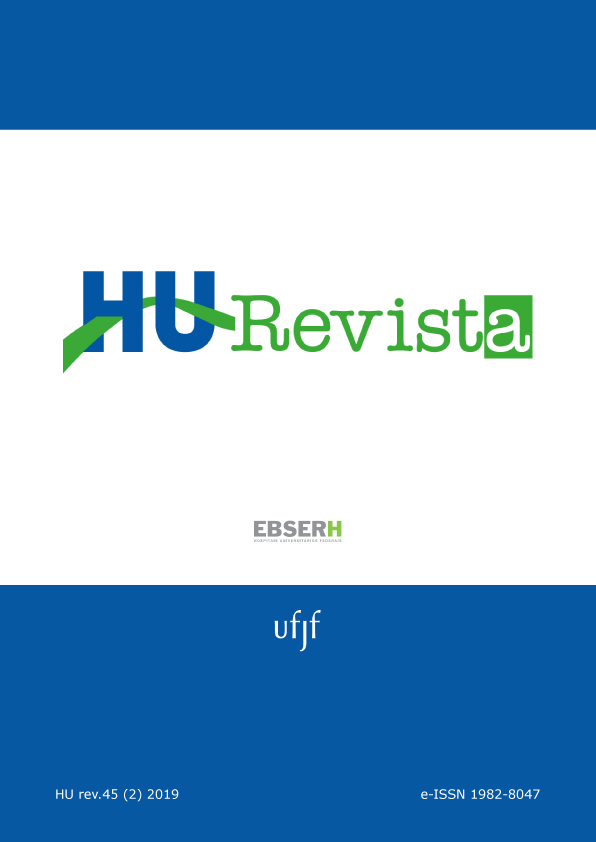Comparison between diagnostic methods for the quantification of low-density lipoprotein in patients attended at a University Hospital
DOI:
https://doi.org/10.34019/1982-8047.2019.v45.27464Keywords:
Hypercholesterolemia, LDL-Cholesterol, Lipoproteins, Laboratory Diagnostics, AtherosclerosisAbstract
Introduction: Studies have reported a strong link between dyslipidemia and atherosclerosis. For this reason, exams such as the lipid profile are routinely performed for the prevention and monitoring of these diseases. Among the lipid indices, low density lipoproteins should be highlighted because due to their greater relation with risk factors for the development of atherosclerotic diseases. Therefore, direct methods of obtaining low density lipoproteins values, considered more accurate, are confronted with results usually obtained in the routine, through equations that provide estimated values. Objective: We compared the diagnostic methods used to obtain low density lipoproteins through the Friedewald and Martin formulas with the results obtained by automated methodology in patients attended at a University Hospital of Juiz de Fora – MG. Material and Methods: A total of 208 patients were recruited and venous blood samples were collected to obtain serum. The levels of total cholesterol, triglycerides and high density lipoprotein were quantified to obtain low density lipoproteins through the Friedewald and Martin equations. Results: A positive correlation between low density lipoproteins results has calculated by Martin and direct methods (ρ = 0.916), and positive correlation between Friedewald results and direct (ρ = 0.915). Discussion: We observed a positive correlation between the values of cholesterol and low density lipoproteins by the three methodologies. The Bland-Altman method has been used to compare the results obtained in search and methodology. Conclusion: Although the Friedewald and Martin equations have a good correlation with low density lipoproteins as measured by direct methodology, studies that relate atherosclerotic arterial diseases to low density lipoproteins should consider the direct quantification of this lipoprotein in order to cover individuals with their different specificities.
Downloads
References
Barbalho SM, Bechara MD, Quesada K, et al. Síndrome metabólica, aterosclerose e inflamação: tríade indissociável. J Vasc Bras. 2015; 14(4):319-27.
Sitrângulo Junior SJ, Silva ES. Doença aterosclerótica carotídea. J Vasc Bras. 2018; 17(3):179-83.
Costa CPA, Machado DC, Oliveira GGP. Estilo de vida como fator de prevenção da aterosclerose. Caderno de Med. 2019; 2(2).
Carapeto C, Montanari F, Pinela LM. Alimentação e aterosclerose: um artigo informativo. Rev Bras de Obesidade, Nutrição e Emagrecimento. 2017; 11(69):755-63.
Faludi AA, Izar MCO, Saraiva JFK. Atualização da Diretriz Brasileira de Dislipidemias e Prevenção da Aterosclerose. Arq Bras de Cardiol. 2017; 109(2).
Motta VT. Bioquímica clínica para o laboratório: princípios e interpretações. 5. ed. Rio de Janeiro: Medbook; 2009.
Friedewald WT, Levy RI, Fredrickson DS. Estimation of the concentration of low density lipoprotein cholesterol in plasma, without use of the preparative ultracentrifuge. Clin Chemis. 1972; 18:499-502.
Jongseok L, Jang S, Jeong H. Validation of the Friedewald formula for estimating low density lipoprotein cholesterol: the Korea National Health and Nutrition Examination Survey, 2009 to 2011. Korean J Intern Med Archive. 2018.
Jialal I, Inn M, Siegel D, Devaraj S. Underestimation of low density lipoprotein-cholesterol with the Friedewald Equation versus a direct homogenous low density lipoprotein-cholesterol assay. Lab. Medicine. 2017; 48(3):220-24.
Olga AH, Alcántara TS, Sánchez JB. Bajos niveles de triglicéridos no afectan el cálculo de lipoproteínas de baja densidad por la fórmula de Friedewald. 2017; 64(3):110-13.
Sathiyakumar V, Golozar A, Lazo M. Comparison of the novel method versus the Friedewald equation in estimating low-density lipoprotein-cholesterol based on fasting status. J Am Coll Cardiol. 2017; 69(11):1697.
Biyik I, Isiksacan N, Koser M. Comparison of alternative formulas for low density lipoprotein cholesterol measurement with Friedewald formula. Am J of Cardiol. 2018; 121(8):104-5.
Martin SS, Blaha MJ, Elshazly MB, Brinton EA, Toth PP, McEvoy JW. Friedewald-Estimated versus directly measured low-density lipoprotein cholesterol and treatment implications. J Am Col Cardiol. 2013:732–9.
National cholesterol education program. Third report of the expert panel on detection evaluation and treatment of high blood cholesterol in adults; 2013 [citado em 2018 Mar 4]. Disponível em: https://www.nhlbi.nih.gov/health-topics/management-blood-cholesterol-in-adults.
Moore DAS. Estatística básica e sua prática. 6a ed. Rio de Janeiro: LTC; 2014.
Sokal, RR e Rohlf FJ. Biometry: the principles of statistics in biological research. New York: Freeman; 1995.
Giavarina D. Understanding Bland Altman analysis: biochemia medica. 2015; 25(2):141-51.
Sociedade Brasileira de Análises Clínicas (SBAC). Consenso Brasileiro para a Normatização da Determinação Laboratorial do Perfil Lipídico. 2016, versão1.13. [acesso em 2018 Mar 4] Disponível em: http://www.sbac.org.br/wp-content/uploads/2017/09/ConsensoOficial_PerfilLipidico_2016_v13.pdf
Larsson A, Hagström E, Nilsson LE, Svensson MK. Treatment target reclassification of subjects comparing estimation of low-density lipoprotein cholesterol by the Friedewald equation and direct measurement of LDL-cholesterol. Upsala J Med Sci. 2018; 123(2):94-9.
Vieira PL, Araujo GN, Telo GH. Valores de LDL-colesterol estimados pela equação de Friedewald são afetados pelo controle do diabetes. Intern J Cardiovasc Sci. 2016; 29(5):348-54.
Ilanchezhian T, Vanaja R, Rajagopalan B. Comparative study of the estimation of LDL cholesterol by the direct method and Friedewald equation in secondary hyperlipidemia. Intern J Pharmac Sci Research. 2016; 7(11):4632-6.
Kurniawan LB, Windarwati W, Budi M. Analysis of LDL-c measurement using direct and Friedewald formula in type 2 diabetes mellitus patients. Indon J Clin Pathol Medical Lab. 2018; 24(3):255-57.
Martin SS. Calculating LDL cholesterol in familial combined hyperlipidemia: out with the old, in with the new? Atherosclerosis. 2018; 277:172-74.
Additional Files
Published
How to Cite
Issue
Section
License
Cessão de Primeira Publicação à HU Revista
Os autores mantém todos os direitos autorais sobre a publicação, sem restrições, e concedem à HU Revista o direito de primeira publicação, com o trabalho licenciado sob a Licença Creative Commons Attribution que permite o compartilhamento irrestrito do trabalho, com reconhecimento da autoria e crédito pela citação de publicação inicial nesta revista, referenciando inclusive seu DOI.









